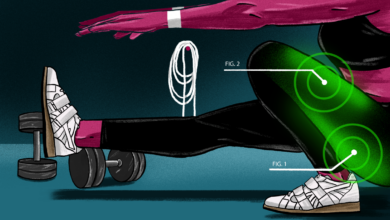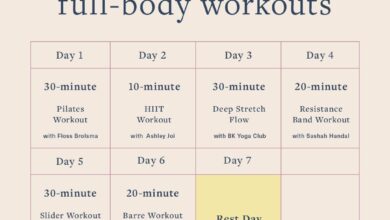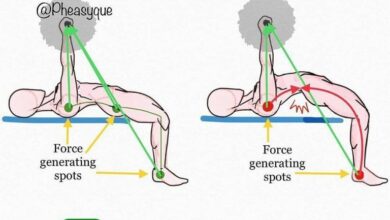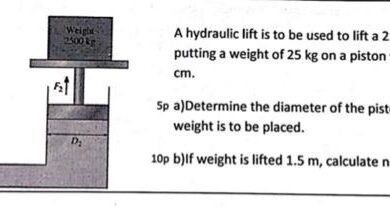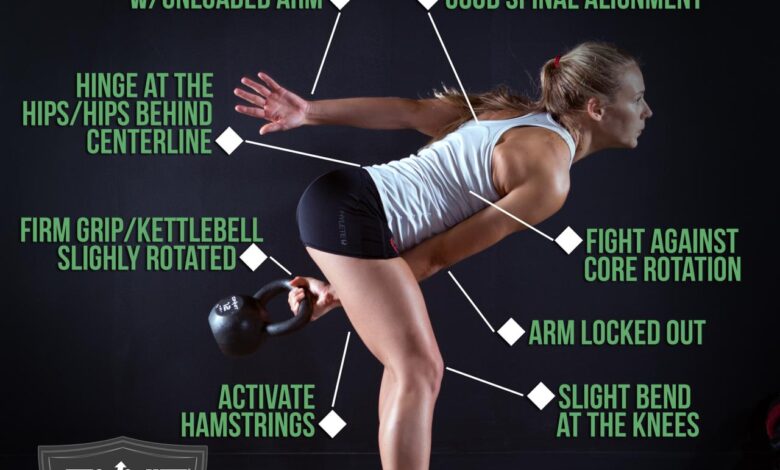
Beginners Guide to the Kettlebell Swing
Beginners guide to the kettlebell swing – The kettlebell swing, a seemingly simple yet powerful exercise, is a cornerstone of functional fitness. This beginner’s guide will demystify the technique, explore its benefits, and guide you through a safe and effective journey into the world of kettlebell training.
You’ll learn the proper stance, grip, and movement mechanics, while understanding the importance of core engagement and hip hinge. We’ll delve into variations, safety precautions, and how to incorporate kettlebell swings into your fitness routine.
From mastering the basic swing to exploring different variations, this guide is designed to equip you with the knowledge and confidence to make the kettlebell swing a valuable part of your fitness journey. Whether you’re looking to build strength, improve cardiovascular health, or simply add variety to your workouts, the kettlebell swing offers a unique and rewarding experience.
Introduction to Kettlebell Swings
The kettlebell swing is a dynamic exercise that engages multiple muscle groups, making it an excellent choice for beginners looking to improve their overall fitness. It’s a foundational movement that builds strength, power, and cardiovascular endurance.
Benefits of Kettlebell Swings for Beginners
Kettlebell swings offer numerous benefits for beginners, including:
- Improved Posture:The swing motion strengthens the muscles in the back, core, and glutes, promoting proper posture and reducing the risk of back pain.
- Enhanced Core Strength:The kettlebell swing engages the core muscles throughout the entire movement, building strength and stability.
- Increased Power:The explosive nature of the swing helps develop power and explosiveness, which can translate to other activities.
- Improved Cardiovascular Health:The swinging motion elevates heart rate and improves cardiovascular fitness.
- Versatility:Kettlebell swings can be modified to suit different fitness levels and goals.
Anatomy of the Kettlebell Swing
The kettlebell swing is a compound exercise that involves a coordinated movement of the hips, glutes, and back muscles. Here’s a breakdown of the key components:
- Hip Hinge:The swing starts with a hip hinge, where the hips move back and the torso leans forward while maintaining a straight back.
- Power Generation:The power for the swing comes from the hips and glutes, which explosively extend and propel the kettlebell forward.
- Swinging Motion:The kettlebell swings in a pendulum-like motion, traveling between the legs and up to chest height.
- Controlled Return:The kettlebell is brought back down under control, using the same hip hinge motion.
History of the Kettlebell Swing
Kettlebells have been used for centuries, dating back to ancient Greece and Russia. The kettlebell swing, in its modern form, emerged in the 20th century as a popular exercise in strength and conditioning programs. It gained widespread recognition in the West in the late 20th and early 21st centuries, becoming a staple exercise in various fitness disciplines.
Kettlebell Swing Basics
The kettlebell swing is a fundamental exercise that engages multiple muscle groups, improves core strength, and enhances power and explosiveness. Mastering the basic principles is crucial for performing the swing safely and effectively.
Proper Stance and Grip
A solid stance and grip are essential for maintaining balance and control during the swing.
- Feet shoulder-width apart:Position your feet slightly wider than shoulder-width apart, with your toes pointing slightly outward. This provides a stable base for the movement.
- Kettlebell in front of you:Place the kettlebell between your legs, ensuring that it is within easy reach. Your feet should be positioned so that you can comfortably reach the kettlebell without straining.
- Overhand grip:Grasp the kettlebell handle with an overhand grip, ensuring your thumbs are wrapped around the handle. This grip provides a secure hold and allows for a powerful swing.
- Neutral spine:Maintain a neutral spine throughout the movement. Avoid rounding your back or arching your lower back.
Core Engagement and Hip Hinge
Engaging your core and mastering the hip hinge movement are vital for generating power and minimizing risk of injury.
- Core engagement:Engage your core muscles, including your abdominal muscles and obliques, throughout the swing. This helps to stabilize your spine and prevent unwanted movement.
- Hip hinge:The hip hinge movement is the key to a proper kettlebell swing. It involves hinging at your hips, pushing your hips back, and keeping your back straight. The movement should be initiated from the hips, not the back.
Proper Swing Motion
The kettlebell swing involves a smooth and controlled motion that utilizes the power of your hips and legs.
Mastering the kettlebell swing is a great way to boost your metabolism and build strength, especially during the holidays when it’s easy to indulge in delicious but calorie-dense treats. If you’re looking for tips on how to build a healthier holiday plate , check out this helpful resource! Once you’ve got your nutrition in check, you can confidently incorporate the kettlebell swing into your fitness routine and enjoy the benefits of a stronger, healthier you.
- Start position:Stand with your feet shoulder-width apart, kettlebell in front of you, and your back straight. Engage your core and maintain a neutral spine.
- Hip hinge:Initiate the swing by hinging at your hips, pushing your hips back, and bending your knees slightly. Keep your back straight and your core engaged. The kettlebell should swing between your legs.
- Swing up:Explosively extend your hips and drive your body forward, swinging the kettlebell up to chest level. Maintain a straight back and engage your core throughout the movement.
- Return to start position:Allow the kettlebell to swing back down between your legs. Control the movement by engaging your core and maintaining a neutral spine.
- Repeat:Continue the swing motion for the desired number of repetitions.
Kettlebell Swing Variations: Beginners Guide To The Kettlebell Swing
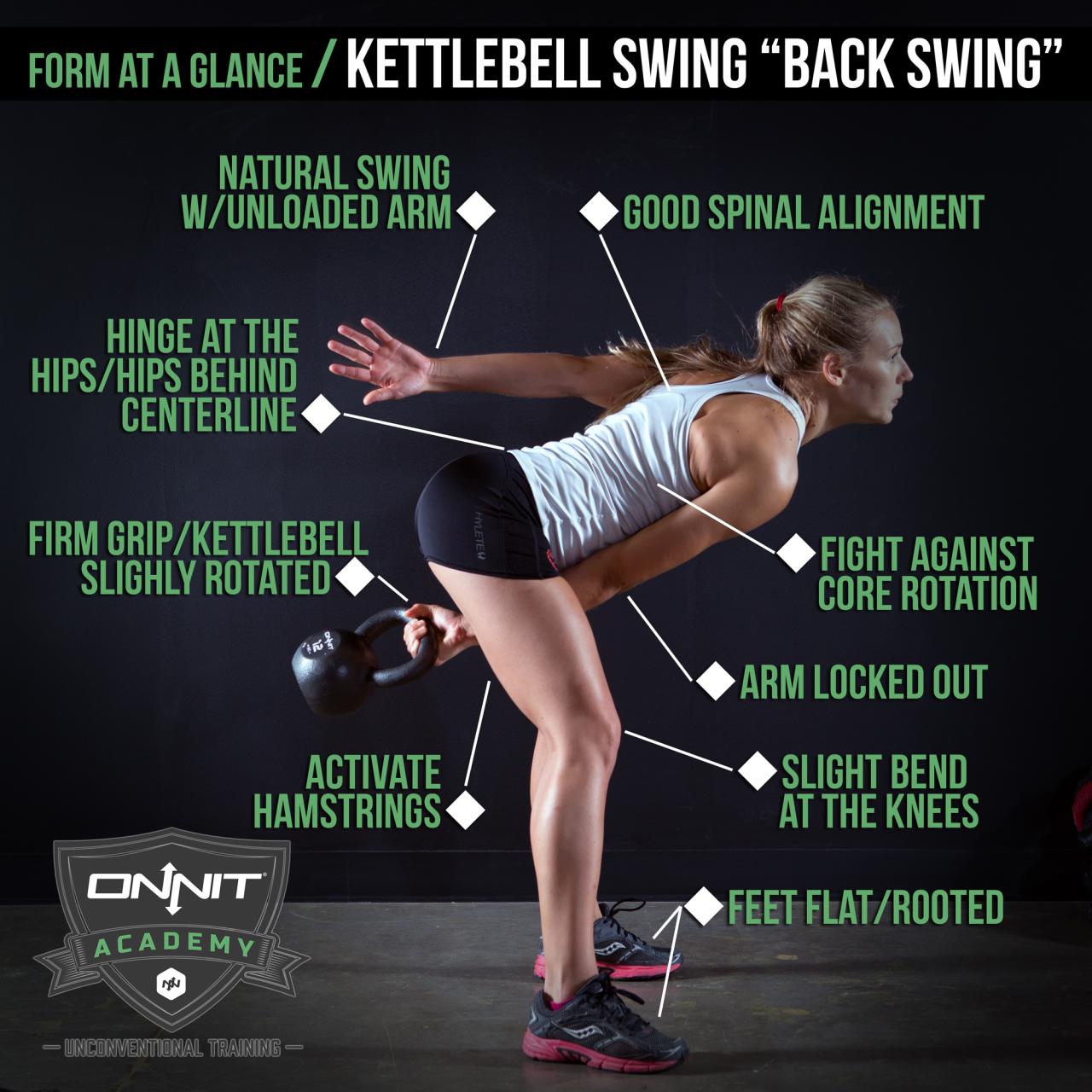
The kettlebell swing is a versatile exercise with numerous variations that target different muscle groups and offer unique challenges. Understanding the variations can help you personalize your workouts and achieve your fitness goals.
American Kettlebell Swing, Beginners guide to the kettlebell swing
The American swing emphasizes hip extension and focuses on driving the kettlebell through a full range of motion. This variation is often used for building power and explosiveness.
The kettlebell swing is a fantastic exercise for building strength and power, but it can be intimidating for beginners. If you’re feeling overwhelmed by the learning curve, remember to take breaks and prioritize your mental well-being. Check out this helpful article on 10 ways to stay sane when working from home for some great tips.
Once you’ve got your mind in the right place, you’ll be able to focus on mastering the proper form and reaping the benefits of this dynamic exercise.
Benefits
- Increased power and explosiveness
- Enhanced hip mobility
- Improved core strength
Challenges
- Requires good hip flexibility
- Can be challenging for beginners
- May place stress on the lower back if not performed correctly
Russian Kettlebell Swing
The Russian swing emphasizes hip hinge and focuses on maintaining a more upright posture throughout the movement. This variation is often used for developing core strength and improving hip mobility.
Benefits
- Improved core strength and stability
- Enhanced hip mobility
- Reduced stress on the lower back
Challenges
- Requires good hip flexibility
- May be less explosive than the American swing
- Can be challenging to maintain proper form
Romanian Kettlebell Swing
The Romanian swing emphasizes hamstring engagement and focuses on a controlled, lower-amplitude movement. This variation is often used for improving hamstring flexibility and building strength in the posterior chain.
Benefits
- Improved hamstring flexibility and strength
- Enhanced glute activation
- Reduced stress on the lower back
Challenges
- Requires good hamstring flexibility
- May be less explosive than other variations
- Can be challenging to maintain proper form
Visual Comparison of Kettlebell Swing Variations
| Variation | Description | Image |
|---|---|---|
| American Swing | Emphasis on hip extension, full range of motion | [Image description: An individual performing an American kettlebell swing, with the kettlebell moving in a wide arc from between their legs to above their head] |
| Russian Swing | Emphasis on hip hinge, upright posture | [Image description: An individual performing a Russian kettlebell swing, with the kettlebell moving in a shorter arc from between their legs to approximately chest height, maintaining an upright posture] |
| Romanian Swing | Emphasis on hamstring engagement, controlled movement | [Image description: An individual performing a Romanian kettlebell swing, with the kettlebell moving in a short arc from between their legs to approximately hip height, with a focus on hamstring engagement] |
Safety and Precautions
Kettlebell swings are a fantastic exercise for building strength, power, and conditioning. However, like any exercise, it’s crucial to prioritize safety to avoid potential injuries. This section will address common mistakes, potential injuries, and provide tips for safe kettlebell swing practice.
Common Mistakes and Potential Injuries
Performing kettlebell swings incorrectly can lead to several injuries, including: * Lower back pain:This can occur due to improper form, particularly if the hips are not fully extended during the swing.
Shoulder pain Incorrect technique, such as using momentum instead of controlled power, can strain the shoulder joint.
Wrist pain Holding the kettlebell too tightly or with an improper grip can lead to wrist strain.
Groin strain Overextending the hips or using excessive force can put stress on the groin muscles.
Tips for Safe Kettlebell Swing Practice
Here are some essential tips for safe kettlebell swing practice:* Start with a light weight:Choose a kettlebell that allows you to maintain proper form throughout the entire movement.
Mastering the kettlebell swing is a fantastic way to build strength and power, and it’s a great exercise for beginners. But just like your workout routine, your diet plays a crucial role in your fitness journey. It’s important to fuel your body with the right nutrients, which is why understanding why quality of carbs matters on a low carb diet can be a game-changer.
By choosing nutrient-dense carbs, you’ll have the energy to power through those kettlebell swings and see even better results.
Focus on proper form Master the basic technique before attempting variations or increasing the weight.
Engage your core Keep your core muscles tight throughout the swing to protect your spine.
Avoid hyperextension Do not overextend your back at the top of the swing.
Use a controlled motion The swing should be a smooth, controlled movement, not a jerky or explosive one.
Listen to your body If you experience any pain, stop immediately and consult a healthcare professional.
Warm-Up and Cool-Down
Proper warm-up and cool-down routines are essential for injury prevention and performance optimization:* Warm-up:Before starting your kettlebell swing workout, engage in light cardio, such as jumping jacks or light jogging, followed by dynamic stretching, like arm circles, leg swings, and torso twists.
Cool-down After your workout, engage in static stretching, holding each stretch for 30 seconds. Examples include hamstring stretches, quad stretches, and chest stretches.
Building a Kettlebell Swing Routine
Once you’ve mastered the basic kettlebell swing, it’s time to incorporate it into a workout routine. A well-structured routine will help you build strength, improve cardiovascular fitness, and enhance your overall athleticism.
Sample Kettlebell Swing Workout Routine for Beginners
This routine is designed for beginners and can be adjusted based on your fitness level.
- Warm-up:5 minutes of light cardio, such as jogging or jumping jacks, followed by dynamic stretches, like arm circles and leg swings.
- Kettlebell Swings:Perform 3 sets of 10-12 repetitions. Rest for 1 minute between sets.
- Other Exercises:Include 2-3 other exercises that target different muscle groups, such as squats, lunges, or push-ups. Perform 3 sets of 10-12 repetitions for each exercise.
- Cool-down:5 minutes of static stretches, holding each stretch for 30 seconds.
Choosing the Right Kettlebell Weight
Selecting the appropriate kettlebell weight is crucial for effective and safe training.
- Start Light:Begin with a weight that allows you to maintain proper form throughout the entire set. You should feel challenged but not overly strained.
- Listen to Your Body:If you find yourself struggling to complete the sets with good form, reduce the weight. Conversely, if the exercise feels too easy, increase the weight.
- Progressive Overload:As you get stronger, gradually increase the weight to continue challenging your muscles.
Progressing Your Kettlebell Swing Routine Over Time
As you become more comfortable with the kettlebell swing, you can gradually increase the intensity and volume of your workouts.
- Increase Repetitions:Start by adding one or two repetitions to each set as you progress.
- Increase Sets:Once you can comfortably perform 15-20 repetitions per set, add another set to your routine.
- Increase Weight:As you gain strength, consider increasing the weight of the kettlebell by 5-10 pounds. However, prioritize proper form over weight.
- Add Variations:Once you’ve mastered the basic kettlebell swing, explore different variations, such as the American kettlebell swing or the Russian kettlebell swing. These variations challenge your muscles in different ways and add variety to your routine.
Kettlebell Swing Applications
Kettlebell swings are a versatile exercise with numerous applications beyond building strength and endurance. They can be incorporated into various fitness programs, enhancing athletic performance and improving overall fitness.
Kettlebell Swings for Strength Training
Kettlebell swings are a compound exercise that engages multiple muscle groups, making them an effective tool for building strength. The swing motion targets the glutes, hamstrings, and lower back, contributing to a stronger posterior chain. Additionally, the core muscles are activated to maintain stability throughout the movement, enhancing core strength.
Kettlebell Swings for Cardio
Kettlebell swings are a dynamic exercise that elevates the heart rate, providing a cardiovascular workout. Performing swings in a continuous manner with a moderate weight can significantly increase heart rate and calorie expenditure, making them an excellent addition to any cardio routine.
Kettlebell Swings for Flexibility
Kettlebell swings improve flexibility by promoting mobility in the hips and lower back. The swinging motion stretches the muscles in these areas, enhancing range of motion and reducing stiffness.
Kettlebell Swings for Athletic Performance
Kettlebell swings can improve athletic performance in various ways. They enhance power generation, which is crucial for explosive movements in sports like basketball, tennis, and sprinting. The swing motion also improves hip mobility and core strength, both of which are essential for optimal athletic performance.
Integrating Kettlebell Swings into Other Exercises
Kettlebell swings can be seamlessly integrated into other exercises, creating a more challenging and effective workout. For instance, incorporating swings between sets of squats or lunges can increase heart rate and enhance calorie expenditure. Additionally, swings can be used as a warm-up or cool-down exercise, preparing the body for more intense workouts or promoting muscle recovery.
Closing Summary
By mastering the kettlebell swing, you unlock a gateway to a world of functional fitness possibilities. From building strength and improving cardiovascular health to enhancing flexibility and athletic performance, the kettlebell swing offers a versatile and effective exercise for individuals of all fitness levels.
Embrace the journey, practice with patience, and discover the transformative power of this dynamic movement.

